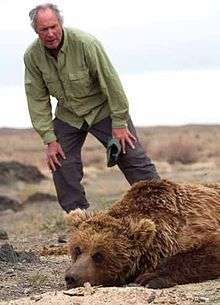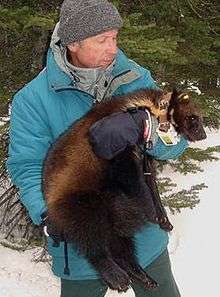Douglas H. Chadwick

Douglas H. Chadwick (born 1948) is an American wildlife biologist, author, photographer and frequent National Geographic contributor. He is a past officer and current member of the board of The Vital Ground Foundation, and chairman of that organization's Lands Committee, responsible for choosing acquisition properties as part of the Yellowstone to Yukon wildlife corridor system. Chadwick is also a director of the Gobi Bear Fund, part of the Gobi Bear Initiative,[1] which attempts to restore population of this most endangered of all the yellow bears.
Chadwick's affiliation with National Geographic spans more than thirty-five years and more than fifty articles from the first in 1977[2] up to assignments in 2013 for articles on cougars, wolverines and Gobi bears.
Single species studies
Chadwick's research involves multi-year projects of extended close observation in species habitat, trapping, radio collar tracking, mapping, and studies of community relationships. In this manner, he has studied wolverines[3] in the northwestern U.S. and Canada, mountain goats[4] and grizzlies[5] in the Rockies, and elephants[6] in Africa.
Wildlife corridors
In his work for Vital Ground, Chadwick evaluates potential corridor lands to link the five protected grizzly bear habitats in the lower 48 states and British Columbia and Alberta in Canada. He has guided land and easement acquisitions in, for example,the Cabinet-Purcell Wildlife Linkage Initiative Area,[7] the Selkirk Initiative,[8] and the Bismark Meadows in Idaho.[9]

Glacier Wolverine Project
In 2006, Chadwick began what would become a five-year participation in the Glacier Wolverine Project,[10] to follow a small set of wolverines as they traveled over their extensive habitat centered on and around Glacier National Park (U.S.). This study was the subject of Chadwick's book, The Wolverine Way,[3] and the PBS/Nature documentary "Wolverine: Chasing the Phantom."[11] Chadwick played a major on-screen role in the Nature documentary. The Glacier Wolverine Project was conducted by the U.S. Forest Service, Rocky Mountain Research Station, Missoula, Montana, under the leadership of principal investigator, Jeffrey Copeland.[12]
Bibliography
Scientific publications
- 1974. Mountain Goat Ecology-Logging Relationships in the Bunker Creek Drainage of Western Montana. M.S. Thesis, University of Montana, 262pp.
- 1977. The influence of Mountain Goat Social Relationships on Population Size and Distribution. Proceedings of First International Symposium on Mountain Goats, William Samuel and W.G. McGregor, editors. British Columbia Ministry of Recreation and Conservation, Fish and Wildlife Branch.
- 1979. Ecological Relationships of Mountain Goats (Oreamnos americanus) in Glacier National Park, Montana. Proceedings of First Conference on Scientific Research in the National Parks. U.S. Dept. Interior, NPS Transactions and Proceedings Series No. 5, Vol I, pp 451–456.
- 1992. A Concentration of Harlequin Ducks in the Strait of Georgia, British Columbia. Proceedings of the First Harlequin Duck Symposium. Canadian Wildlife Service, Delta, British Columbia.
Books and chapters
- Chadwick, Douglas H. (1983). A beast the color of winter. Sierra Club Books. The natural history, ecology, and behavior of the mountain goat.
Patagonia Books:
- 2010. The Wolverine Way. 275 pages of wolverine ecology, adventure, and discovery based on participation in the Glacier Wolverine Project.
Sierra Club Books:
- 1990. The Kingdom. A large format work on North American wildlife with photography by Art Wolfe. 204pp.
- 1992. The Fate of the Elephant. British Edition by Viking/Penguin. Selected as one of the Best Books of the Year by the New York Times Book Review. 492pp.
- 2003. True Grizz. The lives of some individual bears in northwestern Montana and of the people learning to live with them. 176pp.
- 2006. The Grandest of Lives: Eye to eye with whales.
Globe Pequot Press:
- 2007. Growing up Grizzly. A children’s book – the true story of a big-hearted mother grizzly, her cubs, and an adopted juvenile. Photographs by Amy Shapira.
Bison Books/University of Nebraska Press:
- 2002. A Beast the Color of Winter. Reissue with new introduction.
National Geographic Books:
- 1987. “The Last Wildernesses”. Chapter on Asian deserts, New Guinea, and ethnobiology studies among the Kayapo people of Amazonia, in Into the Unknown.
- 1988. “Mount Kenya”. Chapter on life zones and ecology, in Mountain Worlds.
- 1988. Introduction to 1988 calendar, Natural Wonders of the World.
- 1989. “Guarding Nature’s Heritage. Chapter on Soviet nature reserves, in Nature’s Wonderlands.
- 1990. “Siberia and the Pacific Rim”. Chapter in The Soviet Union Today.
- 1991. “Rocky Shores”. Chapter in The Curious Naturalist.
- 1995. Enduring America. An evocation of our continent’s native life and landscapes. 200pp.
- 1996. Introduction to 1996 calendar, Nature’s World of Wonders.
- 1996. The Company We Keep. America’s Endangered Species, with photographer Joel Sartore. 160pp.
- 2000. Yellowstone to Yukon. Heart of the Rockies bioregion, with photographer Raymond Gehman. 200pp.
- 2002. Exploring America’s Wild & Scenic Rivers. Our national river protection system. 200pp.
Island Press:
- 1991. Introduction to the book Landscape Linkages and Biodiversity, xv-xxvi.
St. Remy Press
- 1993. “Royal Chitwan”. Chapter on Chitwan National Park, Nepal, in Wildest Places on Earth.
The Nature Company:
- 1993. Introduction to Wolf, Spirit of the Wild.
- 1994. Introduction for 1994 wolf calendar.
Key Porter Books:
- “The Grizzly’s Rage to Live”. Chapter in Great Bear Adventures, edited by Andy Russell. Reprinted from Sports Illustrated article, 18 July 1977.
The Lyons Press:
- 2002. “Nerd Science and Miracles in Supratropical Montana”. Chapter on forest ecology in The Roadless Yaak, Rick Bass, ed.
Mountaineers Books:
- 2005. “Y2Y: The Power of Connections”. Introductory chapter to Yellowstone to Yukon: Freedom to Roam.
- 2010. “And Trees in the Salmon.” Summary chapter for Salmon in the Trees, a book on the Tongass National Forest, Alaska, Amy Gulick, photographer.
Riverbend Publishing:
- 2004. “Protecting the Crown”. Afterword to Crown of the Continent, by Ralph Waldt.
Rocky Mountain Land Library:
- 2006. “Real Bear Clawing the Backbone of the World.” Chapter from True Grizz reprinted in The Landscape of Home, an anthology.
Essays and reporting
- Chadwick, Douglas H. (March 2010). "Wolf Wars". National Geographic. 217 (3): 34–55. Retrieved 2014-06-05.
References
- ↑ "Golden Grizzlies of the Gobi" Bare Essentials Magazine, January/February, 2012
- ↑ Douglas H. Chadwick, "The Flathead National Wild and Scenic River" National Geographic, July, 1977.
- 1 2 Chadwick, D.H., The Wolverine Way, Patagonia Books, 2010.
- ↑ A Beast the Color of Winter. Sierra Club Books, 1983. The natural history, ecology, and behavior of the mountain goat. 208pp.
- ↑ “The Great Bear Count” Defenders of Wildlife, Spring, 2009. Census of grizzlies in the Northern Continental Divide Ecosystem.
- ↑ The Fate of the Elephant. Sierra Club Books, 1992. British Edition by Viking/Penguin. Selected as one of the Best Books of the Year by the New York Times Book Review. 492pp.
- ↑ Bare Essentials Magazine, “Protecting the Right Places.”
- ↑ Vital Ground website, “Selkirk Grizzly Bear Habitat Conservation Initiative.”
- ↑ "Bismark Meadows site acquired to aid grizzlies," Bonner County Daily Bee, January 9, 2011
- ↑ Glacier Wolverine Project
- ↑ PBS/Nature documentary, "Wolverine: Chasing the Phantom"
- ↑ Jeffrey P. Copeland, US Forest Service, Rocky Mountain Research Station and Founder of The Wolverine Foundation